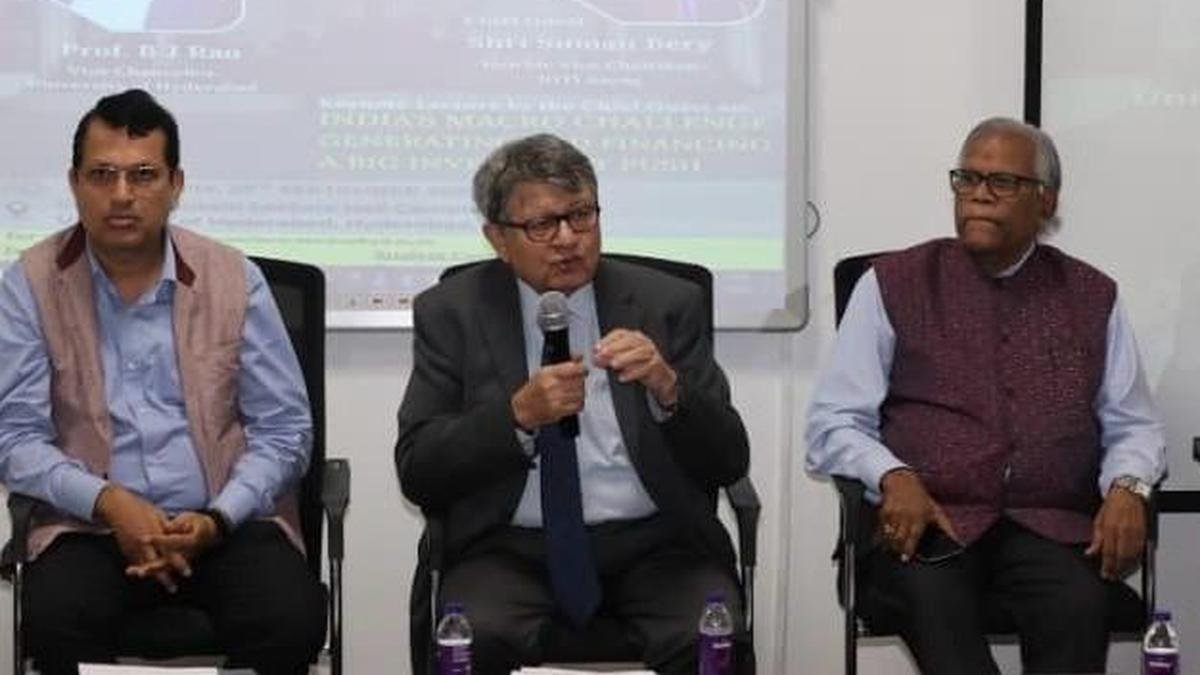Aggregate employment in India increased by 150 million from 2017–18 to 2022–23: NITI Aayog Vice-Chairman Suman Bery


(From left) Debashis Acharya, Dean School of Economics, UoH, Suman K Bery, Vice-Chairman, NITI Aayog, and BJ Rao, Vice-Chancellor, UoH, at the 6th Economics Conclave held in UoH on Monday.
The aggregate employment in India increased by 150 million from 2017–18 to 2022–23 with 80 million women entering agricultural work, according to Suman K. Bery, Vice Chairman, NITI Aayog.
He was speaking on India’s macro challenge: generating and financing a big investment push at the 6th Economics Conclave at the School of Economics, University of Hyderabad (UoH) here on Monday. During the same period, casual workers’ real wages had grown at 2.8 percent per year between 2017-18 and 2022-23, Bery said.
Contrasting India and China, the Vice Chairman of NITI Aayog said China’s “demographic window” opened earlier (1970s), peaked higher and closed sooner while that of India’s opened later, peaked a bit lower but remained wide through mid-century.
“India now maintains a large working-age share for two decades longer than China. India’s “sweet spot” for harvesting its demographic dividend spans about 2025–2035, when the relative size of its workforce is largest before ageing pressures return.’‘ he added.
AGRI GROWTH
On the growth sectors, he said after the decade of 2001 to 2010, agriculture growth steadily accelerated from 3 percent to 4.4 percent as the primary sector was catching up with the growth in the manufacturing sector, Bery said, adding: “Agriculture is poised for further acceleration to 5 percent growth rate with right set of initiatives, a significant contributions towards the goal of Viksit Bharat.’‘
Employment expansion in agriculture had a greater share of female employment as men were released for more productive non-farm work. For many states (e.g. Madhya Pradesh) agriculture is a key engine of growth, Bery said.
DISPARITIES
There are significant inter-state income disparities which had widened over the last three decades, the economist said, adding that the high-income states (e.g., Maharashtra, Gujarat, Tamil Nadu) account for 26 percent of the population but 44 percent of GDP while the low-income states (e.g., UP, Bihar) had 38 percent of population but accounted for only 19 percent of the Gross Domestic Product (GDP).
The growth concentrated in a few states with high shares of manufacturing, FDI, exports, and education, even as the labor mobility remained low with barriers such as non-portable welfare benefits and reliance on informal safety nets, he added.
PATH AHEAD
For India to become an advanced society by 2047, the economy would require about a 7.6 percent CAGR (2023–24 to 2047–48) with an increase in gross fixed capital formation by 2–2.5 percent of the GDP.
“India can boost productivity by promoting greater structural transformation and leveraging global integration,’‘ Bery said
India’s ambition for growth would rest on investment at scale, and the strategy must combine macro management, capital openness, financial modernisation, and fiscal reform. “Growth must be inclusive, resilient, and sustainable. By 2047, India will be a leading global economic power and development model,’‘ Bery said.
Published on September 29, 2025



